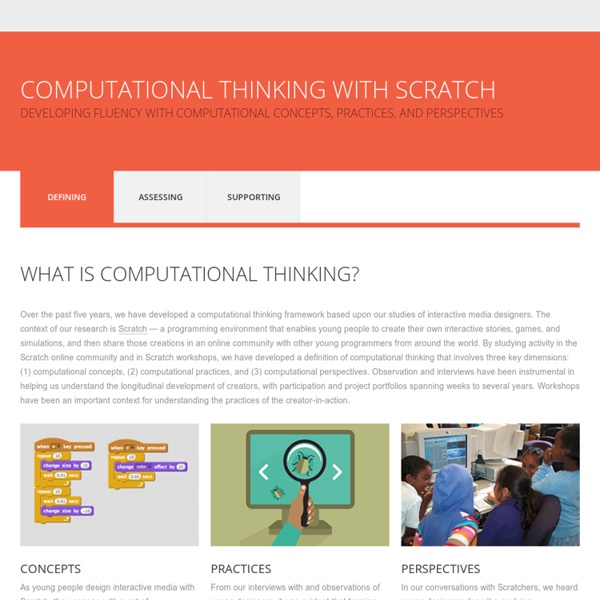Creative Computing
7 units44 activitiesremixing encouraged download the Scratch 3.0 version of the guide> help learnerscreate new worldswith computing
What’s the Difference Between Coding and Computational Thinking?
In my last EdSurge article, “Computer Science Goes Beyond Coding,” I wrote about the difference between coding and computer science, to help us understand what we mean by phrases like “Teach kids to code” and “Computer science for all.” In that article and in many other articles, there is another term that appears often: “Computational thinking.” Well, what is Computational Thinking (CT), and how does it differ from Coding and Computer Science—especially when it comes to classroom practice and instruction? What is Computational Thinking (CT)?
Center for Computational Thinking, Carnegie Mellon
CSUnplugged University of Oregon: Scratch has an amazing online community where kids post their programs and learn from each others’ efforts. Scratch encourages tinkering which is really important in developing computational concepts and skills. Lightbot is a pictorial programming activity that introduces basic computational concepts like recursion.
Computational Thinking for Educators - - Unit 1 - Introducing Computational Thinking
Computational Thinking (CT) is a problem solving process that includes a number of characteristics and dispositions. CT is essential to the development of computer applications, but it can also be used to support problem solving across all disciplines, including the humanities, math, and science. Students who learn CT across the curriculum can begin to see a relationship between academic subjects, as well as between life inside and outside of the classroom. This course provides an opportunity to experience some of the elements of CT, including: Decomposition: Breaking down data, processes, or problems into smaller, manageable parts Pattern Recognition: Observing patterns, trends, and regularities in data Abstraction: Identifying the general principles that generate these patterns Algorithm Design: Developing the step by step instructions for solving this and similar problems The hope is that you will be able to teach CT concepts in your classroom right away.
edsurge
The “teach kids to code” movement has many thinking that computer science is just coding. Often the two are conflated since coding is definitely the most visible component of computer science. It is the magic that turns ideas into products; it provides the motivation to learn computer science.
for Education:
Computational Thinking (CT) is a problem solving process that includes a number of characteristics and dispositions. CT is essential to the development of computer applications, but it can also be used to support problem solving across all disciplines, including math, science, and the humanities. Students who learn CT across the curriculum can begin to see a relationship between subjects as well as between school and life outside of the classroom. CT involves a number of skills, including: These skills are supported and enhanced by a number of dispositions or attitudes that include:
Will.i.am Wants Mandatory Computer Science Classes in Schools
To music artist Will.i.am, technology can change the world. On Tuesday, Will.i.am, the former Black Eyed Peas singer whose legal name is William Adams, dropped by the Apple Store in San Francisco’s Union Square for a screening of the music video for a new version of the group’s 2003 hit Where Is the Love? He was joined by Apple retail chief Angela Ahrendts, and discussed why the proceeds from the song would go toward education programs and initiatives through Adams’ i.am.angel foundation. Specifically, Adams highlighted the importance of making computer science classes available more broadly in schools, especially in disadvantaged neighborhoods. “What success would look like… In every inner city, third period—’where are you going?
Computational Thinking for Educators - Course
What: A free online course helping educators integrate computational thinking into their curriculum Who: Humanities, Math, Science, and Computing educators When: All of the course materials are available as a self-study program. The goal of this course is to help educators learn about computational thinking (CT), how it differs from computer science, and how it can be integrated into a variety of subject areas.
CSTA - Computational Thinking
CSTA Computational Thinking Task Force The purpose of the CSTA Computational Thinking Task Force is to inform and advise CSTA about current developments in computational thinking (CT) and to explore and disseminate teaching and learning resources related to CT. The Task Force will recommend possible projects and directions, and keep the CSTA Board apprised of new developments and initiatives, possible projects for CSTA. Task Force Members: Irene Lee, Chair (Santa Fe Institute, Project GUTS) Fred Martin, Co-Chair (University of Massachusetts Lowell) J. Philip East (University of Northern Iowa) Diana Franklin (University of California, Santa Barbara) Shuchi Grover (Stanford University) Roxana Hadad (Northeastern Illinois University) Joe Kmoch (University of Wisconsin-Milwaukee) Michelle Lagos (American School of Tegucigalpa) Eric Snow (SRI)
Swift
Introducing Swift 5.1 Swift 5.1 now makes it easier to create and share binary frameworks with others. It also includes features that make it easier to design better APIs and reduce the amount of common boilerplate code.
App Inventor
Get Started Follow these simple directions to build your first app! Tutorials Step-by-step guides show you how to create even more apps. Teach
6 Surprising STEM Stats and Why They Matter to You – Ozobot
It’s definitely a term you’ve heard before with some importance attached to it. But what is STEM exactly and why should it matter to you? Well, I’m glad you asked… First, let’s talk basics: STEM stands for Science, Technology Engineering and Math
Which Linux Operating Systems We Use and Why
Advertisement We really want you to start using Linux. But as there are so many Linux operating systems to choose from, some of which we’ve featured here, it can be tricky to decide which one to get started with.



